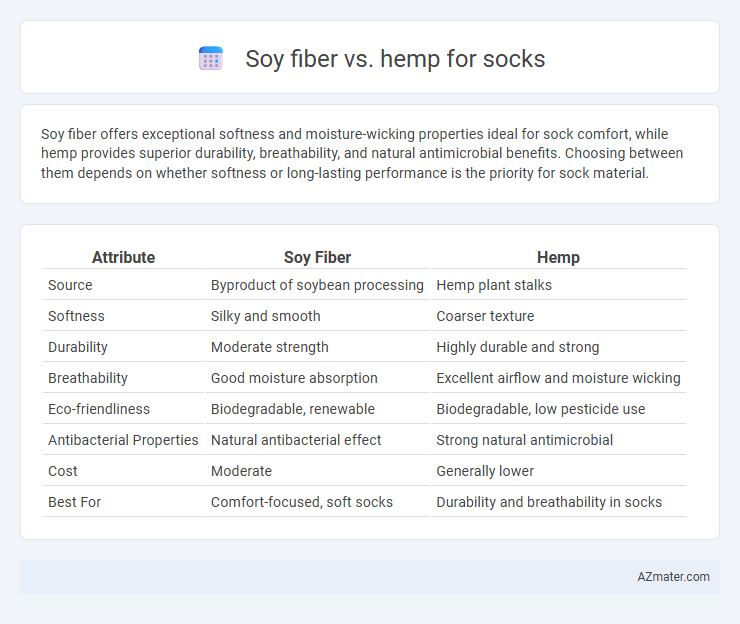Soy fiber offers exceptional softness and moisture-wicking properties ideal for sock comfort, while hemp provides superior durability, breathability, and natural antimicrobial benefits. Choosing between them depends on whether softness or long-lasting performance is the priority for sock material.
Table of Comparison
| Attribute | Soy Fiber | Hemp |
|---|---|---|
| Source | Byproduct of soybean processing | Hemp plant stalks |
| Softness | Silky and smooth | Coarser texture |
| Durability | Moderate strength | Highly durable and strong |
| Breathability | Good moisture absorption | Excellent airflow and moisture wicking |
| Eco-friendliness | Biodegradable, renewable | Biodegradable, low pesticide use |
| Antibacterial Properties | Natural antibacterial effect | Strong natural antimicrobial |
| Cost | Moderate | Generally lower |
| Best For | Comfort-focused, soft socks | Durability and breathability in socks |
Introduction to Natural Fibers in Socks
Natural fibers such as soy fiber and hemp offer excellent breathability and moisture-wicking properties for socks, enhancing comfort and durability. Soy fiber, derived from soybean protein, provides a soft, smooth texture and natural antibacterial qualities, making socks gentle on sensitive skin. Hemp fibers are strong, resistant to wear, and environmentally sustainable, contributing to long-lasting socks with superior odor control and UV resistance.
What is Soy Fiber?
Soy fiber, derived from the byproducts of soybean processing, offers a sustainable and biodegradable option for sock manufacturing. It features natural moisture-wicking properties and a soft, silk-like texture, enhancing comfort and breathability in socks. Compared to hemp, soy fiber provides better elasticity and a smoother finish while maintaining eco-friendly benefits.
What is Hemp Fiber?
Hemp fiber is a natural textile material derived from the stalks of the Cannabis sativa plant, prized for its durability, breathability, and eco-friendly properties. Compared to soy fiber, hemp offers superior strength, moisture-wicking capabilities, and resistance to odor, making it an ideal choice for high-performance socks. Its sustainable cultivation requires fewer pesticides and less water than conventional fibers, promoting environmental benefits alongside comfort and longevity.
Environmental Impact: Soy vs Hemp
Hemp fibers require significantly less water and pesticides compared to soy fibers, making hemp socks more sustainable and environmentally friendly. Hemp cultivation improves soil health through natural phytoremediation, whereas soy farming often involves intensive land use and contributes to deforestation. The biodegradability of hemp fibers ensures minimal ecological footprint post-consumer use, contrasting with soy-based fibers that may involve more processing chemicals.
Comfort and Feel: Comparing Soy and Hemp Socks
Soy fiber socks offer a silky, smooth texture that enhances foot comfort with natural moisture-wicking properties, reducing odor and irritation during wear. Hemp socks provide a coarser feel but excel in durability and breathability, promoting superior air circulation and temperature regulation. Both fibers are eco-friendly, yet soy prioritizes softness while hemp emphasizes sturdiness and ventilation for distinct comfort experiences.
Durability and Longevity of Soy vs Hemp
Hemp fibers exhibit superior durability and longevity compared to soy fibers due to their natural strength and resistance to wear, making them ideal for high-quality socks. Soy fibers tend to be softer but less robust, leading to quicker degradation under frequent use and washing. Hemp's long-lasting qualities ensure socks retain shape and performance over time, providing better value for extended wear.
Moisture Wicking and Breathability
Soy fiber offers excellent moisture-wicking properties, drawing sweat away from the skin to keep feet dry and comfortable during extended wear. Hemp fibers provide superior breathability due to their naturally porous structure, allowing air to circulate and reduce odor buildup. Compared to hemp, soy fiber may absorb moisture more efficiently, while hemp excels in maintaining airflow, making both fibers advantageous for high-performance socks.
Skin Sensitivity and Allergies
Soy fiber, derived from soybean proteins, offers exceptional softness and hypoallergenic properties that make it ideal for sensitive skin, reducing irritation and allergic reactions in sock wearers. Hemp fiber is naturally antimicrobial and breathable but may cause irritation for people with very sensitive skin due to its coarser texture. Choosing soy fiber socks provides enhanced comfort and minimizes allergy risks compared to hemp, especially for individuals prone to skin sensitivities.
Cost and Availability
Soy fiber socks are generally more affordable due to widespread production and lower processing costs, making them accessible in mass markets. Hemp socks, while often pricier, benefit from growing consumer demand for sustainable textiles, but limited large-scale hemp farming keeps prices higher and availability more regional. Soy fiber is easily sourced from byproducts of soybean oil production, whereas hemp cultivation faces regulatory challenges impacting consistent supply chains.
Conclusion: Which Fiber is Best for Socks?
Soy fiber offers exceptional softness and natural moisture-wicking properties, making it comfortable for daily wear socks. Hemp fiber provides superior durability, antimicrobial qualities, and breathability, ideal for long-lasting, odor-resistant socks. For optimal sock performance, hemp is best suited for heavy-duty use while soy fiber excels in softness and comfort for casual wear.

Infographic: Soy fiber vs Hemp for Sock
 azmater.com
azmater.com